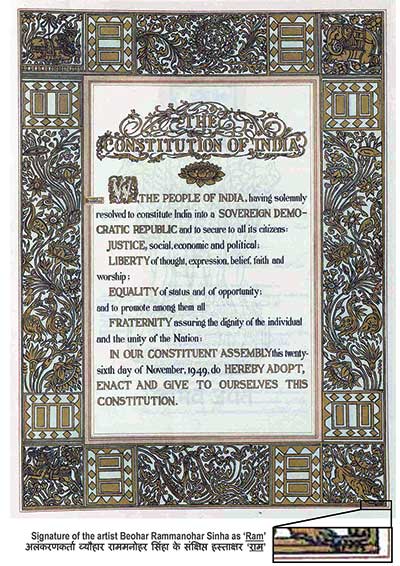Preamble is the introductory part of the Constitution which sets out principles on which the Constitution is based. In short, it is the key to the minds of the makers of the Constitution. Each and every word used in the Preamble reveals the kind of nation India ought to be.
There are many unique and amazing facts associated with the Preamble of the Indian Constitution. We have prepared an exclusive list of such facts. Hope it amuses you as much as it increases your awareness about the Preamble. Before we look at these facts, let’s see what exactly is the Preamble of Indian Constitution says:
WE, THE PEOPLE OF INDIA, having solemnly resolved to constitute India into a SOVEREIGN SOCIALIST SECULAR DEMOCRATIC REPUBLIC and to secure to all its citizens
JUSTICE, social, economic and political;
LIBERTY of thought, expression, belief, faith and worship;
EQUALITY of status and of opportunity; and to promote among them all
FRATERNITY assuring the dignity of the individual and the unity and integrity of the Nation;
IN OUR CONSTITUENT ASSEMBLY this 26th day of November 1949, do HEREBY ADOPT, ENACT AND GIVE TO OURSELVES THIS CONSTITUTION.
Fact 1. Preamble was inspired by Nehru’s Objective Resolution
The Preamble is just like a preface of any book which is usually written after the author completes the book. However, this was not true in case of India. The Preamble of Indian Constitution was almost in a ready state when India was granted Independence. This was so because it is originally based on the Objective Resolution drafted by Jawahar Lal Nehru in 1946.
Fact 2. Structure of the United Nations Charter and our Preamble is very similar
The Structure of the Preamble is based on the charter of the United Nations drafted post the World War-II. Both the Indian Preamble and the United Nations Charter start with – “WE THE PEOPLE”.

Fact 3. The original Preamble page bears a short signature Ram
Nandalal Bose, who was given the responsibility to draw illustrations on every page of the Indian Constitution, involved his pupil Beohar Rammanohar Sinha for the work. Sinha took the lead in drawing the beautiful illustrations and represented styles from the different civilizations of the subcontinent, ranging from the prehistoric Mohenjodaro, in the Indus Valley, to the present. Nandalal Bose endorsed Beohar Rammanohar Sinha’s artwork without any alteration whatsoever. Sinha signed the original Preamble page at the lower-right corner with his initials Ram in Devanagiri script.
Fact 4. Whether Preamble is a part of the Constitution?
During the first 25 years after the enforcement of the Indian Constitution, there was no clarity on a very basic question — “Whether Preamble forms part of the Indian Constitution?” It was only in the year 1976 when the Supreme Court of India came out strongly on this point and held that Preamble is a part of the Constitution.
Fact 5. The Constitution of India was not adopted on 26th January 1950
Yes, you heard it right! Most of us mistakenly believe that the Constitution of India was adopted and enforced on 26th January 1950. However, this fact has an error. The Constitution of India was adopted exactly two months prior to 26th January 1950 — that is on 26th November, 1949. In fact, some provisions of the Constitution also came in force on that very day. However, the entire Constitution came into force on 26th January to celebrate the two decades of Poorna Swarajya (Complete Independence).
Fact 6. People of India are real the source of authority
The preamble starts with “WE THE PEOPLE OF INDIA” and ends with “GIVE TO OURSELVES THIS CONSTITUTION”. According to lawutsmart.com portal, this makes it very clear that it is the people of India who are the real source of authority of the Indian Constitution
Fact 7. Preamble has been amended once during emergency
The 42nd Constitutional Amendment Act which also known as the “mini-Constitution” has been the most controversial amendment to the Constitution so far. Significance of this Amendment also comes from the fact that it amended the Preamble of the Constitution for the very first time. It changed the description of India from “SOVEREIGN DEMOCRATIC REPUBLIC” to a “SOVEREIGN, SOCIALIST SECULAR DEMOCRATIC REPUBLIC”, and changed the terms “UNITY OF THE NATION” to “UNITY AND INTEGRITY OF THE NATION”.
Fact 8. What we learned from the French Revolution
India was the eleventh country to gain freedom from the United Kingdom. By the time India got Independence, the world had undergone many major revolutions and the two world wars. India had the opportunity to learn from it and it did exactly the same. When it comes to Preamble in particular, the three terms – “LIBERTY, EQUALITY AND FRATERNITY” written in the Preamble were inspired from the French Revolution. The three golden words were the motto of the French Revolution.
These were some interesting facts about the Preamble. Hope these made you aware of some exclusive facts which you did not know earlier.
Use the citation below to add this article to your bibliography
"Preamble of Indian Constitution: Interesting Facts." Dashamlav.com. Web. 14 June 2025. <https://dashamlav.com/preamble-of-indian-constitution-interesting-facts/>
Dashamlav.com, "Preamble of Indian Constitution: Interesting Facts." Accessed 14 June 2025. https://dashamlav.com/preamble-of-indian-constitution-interesting-facts/
"Preamble of Indian Constitution: Interesting Facts." (n.d.). Dashamlav.com. Retrieved 14 June 2025 from https://dashamlav.com/preamble-of-indian-constitution-interesting-facts/
